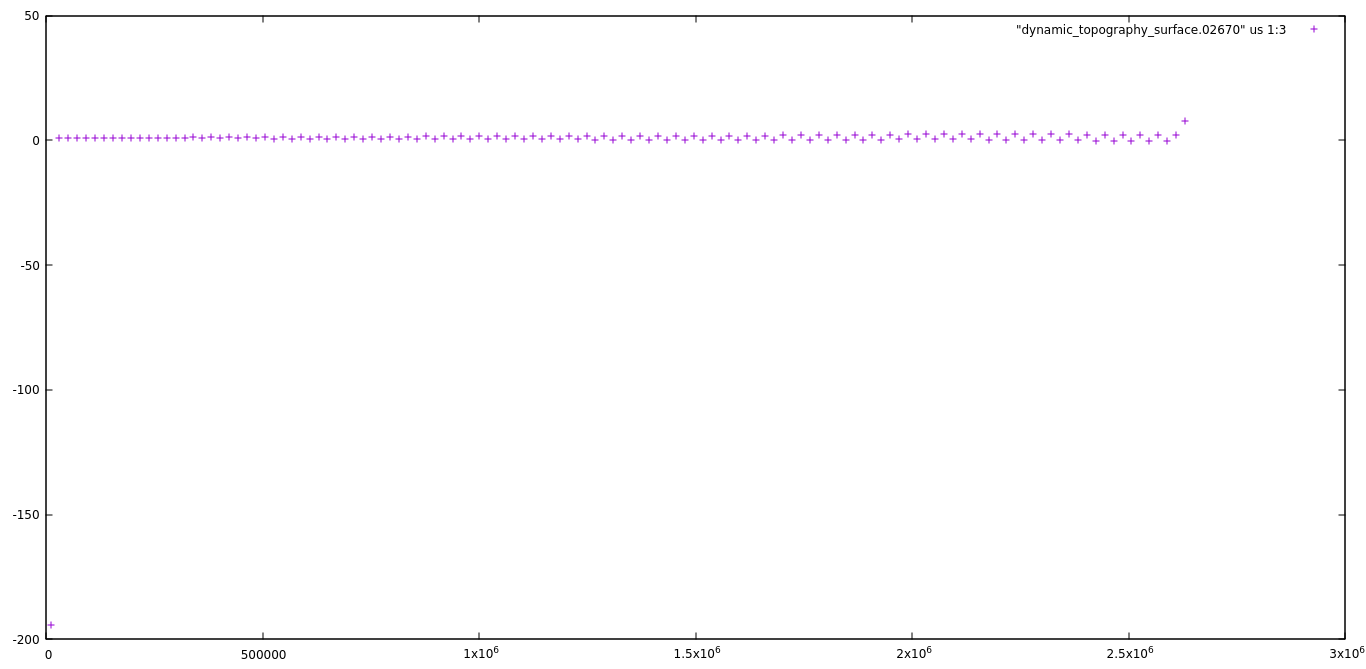Hi all,
I want to plot the dynamic topography of the model with a free surface and a moving plate (achieved by the box with a lithosphere boundary condition). I ran into several problems.
First, even though the x=0, y=0 point is at the bottom left corner of the box, the “dynamic_topography_bottom.0***”, where y=0, seems to be the surface topography, am I right?
Secondly, the above model results are obviously unreasonable. I am wondering why and then I found it might be because the top boundary is under lithostatic pressure:
# free surface
subsection Mesh deformation
set Mesh deformation boundary indicators = top: free surface
subsection Free surface
set Free surface stabilization theta = 0.5
end
end
subsection Boundary traction model
set Prescribed traction boundary indicators = 0:initial lithostatic pressure, 1:initial lithostatic pressure, 3:initial lithostatic pressure
subsection Initial lithostatic pressure
# We calculate the pressure profile at the right model boundary.
set Representative point = 2640e3, 1320e3
end
end
Then I switched off the lithostatic pressure on the top boundary, and the topography variation on the top seems more reasonable (as shown below).
The only difference between the two is I turned off the lithostatic pressure in the later model parameter file:
set Prescribed traction boundary indicators = 0:initial lithostatic pressure, 1:initial lithostatic pressure
Could you please help me check why there is a difference in the surface topography when switching on or off the lithostatic pressure on the top?
Finally, I have a question regarding the viscosity of my model.
I don’t understand why my lowest viscosity in the upper mantle is 5.8e+17 when I set up the minimum viscosity to be 1e+18.
subsection Material model
set Model name = depth dependent
subsection Depth dependent model
set Base model = visco plastic
set Depth dependence method = File
set Data directory = /home/mazq/software/aspect/aspect/data/material-model/depth-dependent/
set Viscosity depth file = visc_depth.txt
set Reference viscosity = 1e22
end
subsection Visco Plastic
set Maximum viscosity = 1e24
set Minimum viscosity = 1e18
set Thermal conductivities = 4
set Phase transition depths = background:410e3|520e3|670e3, C_1: 410e3|520e3|670e3
set Phase transition widths = background:5e3|5e3|5e3, C_1: 5e3|5e3|5e3
set Phase transition temperatures = background:1597.0|1600.0|1605.0, C_1: 1597.0|1600.0|1605.0
set Phase transition Clapeyron slopes = background:4e6|4.1e6|-2.7e6, C_1: 4e6|4.1e6|-2.7e6
set Prefactors for diffusion creep = background:1.25e-15|6.12e-22|2.94e-22|5.4e-25, C_1:1.25e-15|6.12e-22|2.94e-22|5.4e-25
set Activation energies for diffusion creep = background:375e3, C_1:375e3|231e3|270e3|299e3
set Activation volumes for diffusion creep = background:6e-6, C_1:6e-6|6e-6|6e-6|1.5e-6
set Prefactors for dislocation creep = background: 8.33e-17, C_1:8.33e-17|2.05e-12|2.05e-19|1.e-40
set Activation energies for dislocation creep = background:530e3, C_1:530e3
set Activation volumes for dislocation creep = background:1.4e-5, C_1:1.4e-5|1.7e-5|1.7e-5|0
set Densities = background: 3400, C_1:3400|3700|3700|4100
set Heat capacities = background: 3300.0|3394.4|3453.2|3617.6, C_1: 3235.0|3372.3|3441.7|3680.8
end
end
I would greatly appreciate it if you could help me with these questions. Thank you very much!
Cheers
ziqi





